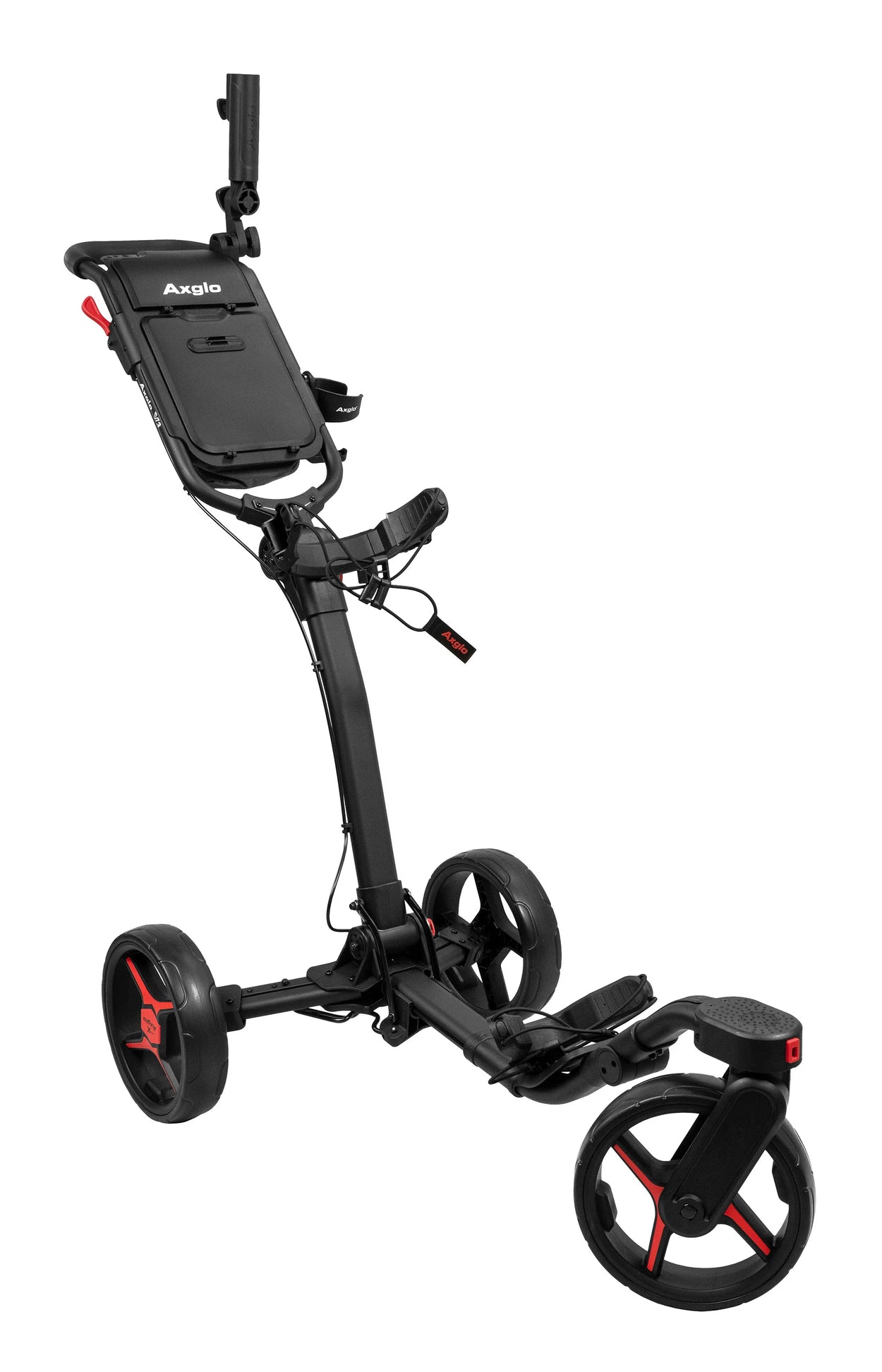ARTICLE
How to Choose the Best Golf Cart Batteries in 2025: The Ultimate Guide
Chris Lang
Read Time: 23 minutes

If you’re searching for the best golf cart batteries in 2025, you’re not alone. With so many options on the market and rapid advancements in battery technology, it can be hard to know which one truly fits your needs.
Whether upgrading an old battery, buying a new cart, or managing a fleet, the right battery can dramatically improve performance, reduce maintenance headaches, and save money in the long run.
In this article, we share all the essentials you need to know before buying a golf push cart battery. Let’s dive right in!
Why Battery Selection Matters for Your Golf Cart
Your golf cart's performance on and off the course depends directly on the battery you choose.
Technically, higher-quality batteries deliver consistent power throughout your round, while lower-quality options may leave you stranded halfway through the back nine.
Also, choosing the wrong batteries can incur unplanned expenses in the future. For instance, using batteries not designed for deep-cycle use can lead to premature failure and frequent replacements. Poor compatibility can also damage other components in your cart, which may be costly to repair. This is why you need to purchase the right golf cart battery from the outset.
If you're exploring modern upgrades, browse our collection of electric golf push carts designed for efficiency and convenience.
Understanding Golf Cart Battery Types
Golf cart batteries come in three types: Lead-acid, AGM (Absorbent Glass Mat), and lithium-ion. Each battery type comes with unique benefits and trade-offs based on your usage and spending preferences.
Let’s explore them in detail:
1. Lead-Acid Batteries
Despite being the oldest technology in the lineup, lead-acid batteries remain relevant in 2025 due to their affordability and accessibility, making them a practical choice for budget-conscious consumers.
They’re best suited for golf carts used occasionally or in predictable environments where regular maintenance isn’t a burden.
Pros:
- Low upfront cost.
- Widely available and easy to replace.
- Decent performance for short-range or occasional use.
- Established maintenance routines and servicing options.
Cons:
- Heavier and bulkier than modern alternatives.
- Requires regular maintenance (e.g., checking water levels).
- Shorter lifespan compared to lithium batteries.
- Longer charging times and lower energy efficiency.
2. AGM Batteries
Absorbent Glass Mat (AGM) technology is more advanced than traditional lead-acid batteries because of its maintenance-free design. These sealed units eliminate water additions, making them more convenient for owners who prefer a hands-off approach.
AGM batteries handle the vibrations and movements associated with golf cart operation, making them well-suited for courses with uneven terrain or carts with frequent use. While they’re more expensive, you’ll save money on replacement and maintenance.
Pros:
- Maintenance-free (no water checks or refills needed).
- Spill-proof and safer for varied terrains.
- More durable and vibration-resistant than flooded lead-acid batteries.
- Faster charging and lower self-discharge rates.
Cons:
- Higher upfront cost than flooded lead-acid batteries.
- Still heavier and less efficient than lithium-ion options.
- Can be sensitive to overcharging if not used with proper chargers.
- Shorter cycle life than lithium batteries.
3. Lithium-Ion Batteries
Lithium-ion batteries are new to the scene but offer more advantages (in weight, performance, and longevity) than previous batteries. They weigh up to 70% less than comparable lead-acid batteries, which:
- Reduces the local weight of your cart,
- Improves range, and
- Minimizes wear on the surrounding mechanical components.
What’s more, these advanced batteries charge faster and deliver consistent power throughout their discharge cycle, eliminating the performance degradation common with lead-acid alternatives. They also offer impressive cycle life, often exceeding 2,000 cycles compared to the 500-700 typical of lead-acid options.
Pros:
- Lightweight, which improves cart efficiency and speed.
- Long lifespan with thousands of charge cycles.
- Maintenance-free and highly reliable.
- Fast charging and high energy density for longer rides.
- Built-in battery management systems (BMS) for safety and performance.
Cons:
- Highest initial cost among all battery types.
- May require specialized chargers or cart modifications.
- Availability and service options can vary depending on the brand.
- Sensitive to extreme temperatures without proper protection.
For an in-depth look at the advantages and trade-offs, here’s a full comparison of golf cart lithium batteries pros and cons.
Which Battery Type Offers the Best Value in 2025?
Value depends largely on your usage patterns and priorities.
For occasional users, lead-acid batteries provide sufficient performance at the lowest upfront cost. For regular users seeking a balance of performance and price, AGM batteries offer compelling benefits with moderate maintenance requirements.
Lithium-ion batteries deliver the best long-term value despite higher price costs.
Key Battery Specifications to Consider
Understanding the technical specifications is crucial when selecting golf cart batteries. This will help you match the battery to your specific needs and cart requirements.
1. Voltage Rating
Voltage rating is critical for your golf cart as it must match your cart’s electrical system. Most golf carts operate on 36V or 48V systems, requiring a series of 6V, 8V, or 12V batteries to achieve the necessary total voltage. Using batteries with incorrect voltage can damage your cart’s controller and motor.
Verify your cart’s controller compatibility before changing the system voltage when upgrading.
2. Amp-Hour Rating
The amp-hour (Ah) rating directly impacts your driving range—higher ratings mean more stored energy and greater distance between charges.
Typical golf cart batteries range from 150Ah to 250Ah, with each additional amp-hour extending your potential range.
A higher Ah rating benefits those who regularly play multiple rounds before charging or using their carts for purposes beyond golfing, such as property maintenance or neighborhood transportation.
When comparing batteries, the Ah rating provides a standardized way to evaluate relative capacity across different brands and models.
3. Cycle Life
Cycle life shows the durability of a battery by tracking how long it maintains performance through repeated use. It’s a key indicator of long-term value. Lead-acid batteries typically last for 500–700 cycles, AGM batteries for 700–1,000 cycles, and lithium-ion options can exceed 2,000 cycles under optimal conditions.
For someone who uses their cart daily, a battery with a higher cycle life means fewer replacements over time.
So, when evaluating manufacturer claims, look for cycle life ratings based on 80% discharge depth, representing realistic usage patterns.
4. Reserve Capacity
Reserve capacity measures how long your batteries can maintain a proper voltage under a continuous load. This is essential when using accessories or navigating rough terrain. This specification tells you how many minutes your battery can deliver a constant 25-amp draw while maintaining a voltage above the minimum threshold.
Higher reserve capacity provides a safety margin for unexpected situations, especially for those who use their carts in remote areas or for extended outings.
Factors Influencing Golf Cart Battery Costs

Several factors affect the price of golf cart batteries, including the battery type, storage capacity, and manufacturer. Lithium-ion batteries are typically the most expensive due to their long life and high performance.
The battery’s capacity, measured in ampere-hours (Ah), also affects the price—the higher the capacity, the higher the cost.
Additionally, exploring solutions for slow golf carts with new batteries can offer insights into maximizing your golf cart’s efficiency and addressing any issues related to underperformance despite having new batteries.
To get a detailed breakdown of average battery pricing and influencing factors, check out how much a golf cart battery costs.
1. Technology and Capacity
The type of technology behind a golf cart battery can significantly affect its price. For instance, lead-acid batteries have been the go-to choice for years due to their cost-effectiveness, but require more maintenance.
On the other hand, lithium-ion batteries offer longevity and better performance with less upkeep but at a higher initial cost. Think of it as comparing a basic flip phone to a modern smartphone; each offers trade-offs in cost and functionality.
The size of the battery also influences its cost. Higher capacity batteries mean longer play times on the course without recharging, much like having a larger gas tank for extended road trips. Opting for more ’miles’ means shelling out extra bucks upfront.
2. Brand Reputation and Warranty
The brand name attached to your golf cart battery isn’t just about flaunting logo stickers on your ride; it’s about reliability backed by reputation—a factor that often influences pricing.
Top-tier brands typically command higher prices because they promise quality assurance through extensive testing processes that you might not find with generic options.
Warranty is another critical factor. A solid warranty reflects the manufacturer’s confidence in their product. Look for warranties that offer at least 3 to 5 years of coverage for lithium-ion options and around 1 to 3 years for lead-acid batteries.
Pay attention to what’s covered — some warranties include full replacement, while others might only cover partial costs or have strict usage clauses.
Pro Tip: Always read the warranty’s fine print and check for terms like “pro-rated” coverage.The longer and more comprehensive the warranty, the better your investment protection.
Calculating the Total Cost of Ownership
How much does it cost to maintain these battery types? Let’s find out:
1. Lead-Acid Batteries
Lead-acid batteries have hidden costs that can add up over time. Due to their shorter lifespan, they typically need replacement every 3 to 5 years.
Additionally, to keep them running smoothly and stave off rusting, you have to stay on top of routine upkeep like refilling the water levels and scrubbing down those connectors.
2. AGM Batteries
Absorbent Glass Mat (AGM) technology offers a step up from traditional lead-acid batteries by eliminating the need for water refills and considerably reducing maintenance efforts. This advantage makes AGM attractive despite its higher upfront cost than standard lead-acid options.
3. Lithium-Ion Batteries
Lithium-ion batteries stand out as the premium choice among battery-operated golf cart owners seeking long-term value. These batteries have life spans reaching up to 10 years under proper care.
Besides lasting longer than alternatives, lithium-ion batteries require minimal to no ongoing maintenance throughout their life cycle, which dramatically lowers long-term costs despite the higher upfront price compared to AGM or lead-acid models.
Choosing the Right Battery for Your Club Car
To kick things off, consider what makes your cart tick. Is it primarily used for leisurely rounds on the golf course, or does it double as a workhorse around your property? This will dictate whether you lean toward batteries with long life cycles or those offering power bursts when needed.
Additionally, consider whether the battery you’re considering aligns with your cart’s make and model specifications. Due to size constraints or voltage requirements, not all batteries fit all carts.
Battery options can be overwhelming, but narrowing down by technology type is a great place to start. For instance, lead-acid batteries have been powering carts forever because they’re cost-effective and reliable if maintained properly. On the flip side, lithium-ion variants are gaining traction in modern fleets thanks to their lighter weight and zero-maintenance appeal.
Environmental Impact and Sustainability
The environmental impact of golf cart batteries varies by type.
While recyclable, lead-acid batteries can pose significant environmental hazards if not properly disposed of due to their lead and acid content.
Lithium-ion batteries have a smaller environmental footprint and are more efficient, but sourcing lithium and recycling these batteries also present challenges.
Choosing batteries with a longer lifespan and supporting recycling programs can mitigate some environmental impacts. Additionally, selecting the best electric golf scooter can further align with environmental sustainability efforts, offering an eco-friendly alternative for personal transportation on the golf course.
1. Lead-Acid Batteries
Despite its considerable ecological toll, the reliable lead-acid battery has been the go-to power source for golf carts for years. While they save money upfront, their environmental impact is notable due to the harmful materials they contain.
Creating these power sources entails using dangerous substances like lead and sulfuric acid, which pose a huge risk if they’re not correctly discarded. However, they are highly recyclable, reusing most of their components in new batteries.
Participating in responsible recycling programs is vital to making the course greener. For example, following EPA standards for battery recycling is crucial to preventing these potentially hazardous substances from damaging the Earth.
2. AGM Batteries
Absorbent Glass Mat (AGM) technology offers a more environmentally friendly alternative to traditional lead-acid options. Sealed AGM batteries minimize acid spill hazards, improving individual safety and safeguarding our planet.
Their streamlined structure ensures minimal energy dissipation throughout the charging and discharging phases, significantly benefiting your wallet and our planet.
3. Lithium-Ion Batteries
Lithium-ion batteries are the eco-champion among golf cart power sources due to their longer lifespan and higher efficiency compared to other types on the market. They boast a smaller carbon footprint over their life cycle because they last longer—meaning fewer replacements—and require less energy to charge fully.
Maintenance Best Practices for Maximum Lifespan
Consistent maintenance is essential for getting the most life out of your golf cart battery.
For lead-acid batteries, ensure proper water levels and clean terminals to prevent corrosion. Avoid deep discharging batteries and ensure they are fully charged after use.
For all battery types, storing them in a cool, dry place and using a smart charger can significantly extend their lifespan.
Other checks are:
1. Charging Practices
To ensure your golf cart battery thrives for as long as possible, you need to adopt and stick to proper charging routines. While giving it a quick charge between rounds is tempting, this can shorten its life.
Instead, fully charge your battery after each use, even if you haven’t drained it completely. This avoids the dreaded memory effect plaguing certain batteries and preserves their longevity.
Avoid leaving your golf cart plugged in all the time. Overcharging can be as harmful as undercharging because it leads to overheating and water loss in lead-acid batteries. Investing in a smart charger that turns off when the battery is full could save you money and headaches.
2. Water Level Monitoring
For flooded lead-acid batteries, check levels monthly during peak usage and bi-monthly during the off-season. Only add distilled water after charging and filling to approximately ¼ inches below the bottom of the fill well.
Importantly, never allow lead-acid batteries to operate with plates exposed above the water line, which causes irreversible damage to the battery structure. Conversely, overfilling dilutes the electrolyte and reduces performance, increasing the risk of acid spillage during charging.
3. Cleaning Routines
Regular cleaning prevents performance-degrading corrosion and buildup on battery surfaces and terminals. Monthly cleaning of battery tops with a baking soda and water solution neutralizes acid residue and prevents conductive paths between terminals that can slowly drain batteries.
Terminal connections should be cleaned quarterly using a wire brush to remove oxidation.Apply a small amount of terminal protection solution after cleaning to minimize the risk of corrosion returning. This simple maintenance step ensures optimal electrical connections and prevents the increased resistance that accelerates terminal damage.
While internal maintenance isn’t required for AGM and lithium batteries, exterior cleaning remains important. Dust and debris can accumulate on battery surfaces and connection points, potentially creating thermal insulation that impedes proper heat dissipation during charging and operation.
Signs It’s Time to Replace Your Golf Cart Battery
Imagine this: You’re ready for a peaceful day on the course, but your golf cart has other plans. If you’ve noticed that your rides are getting shorter or the power seems lackluster, it might be time for a battery check-up. Recognizing the right moment to swap out your golf cart’s battery can shield you from sudden stops and preserve the pleasure of your game.
1. Diminished Capacity
Take note if your golf cart isn’t covering as much ground as it used to on a single charge. This is often the first sign of diminished capacity, indicating that the battery can no longer hold as much energy as before.
While all batteries degrade over time due to chemical reactions within them, significant drops in performance signal that they need to be replaced.
A helpful way to test battery capacity is to fully charge your golf cart and see how far it goes under normal conditions before it needs recharging again.
2. Longer Charging Times
Besides not going the distance like they used to, aging batteries also tend to hog more plug-in time. Initially subtle, these extended charging periods grow increasingly inconvenient and indicate declining efficiency.
When what used to be overnight charges turn into multi-day affairs without delivering improved performance, consider shopping around for replacements.
Last but not least:
3. Physical Damage
Watch for visible signs of wear like bulging, leaking, or cracking, as these issues can affect battery performance and pose safety risks.
Swollen or leaking batteries pose serious risks, both environmental and personal. If you spot these issues, don’t hesitate to replace them immediately.
Conclusion
Selecting the correct golf cart battery in 2025 involves balancing performance needs, budget constraints, and maintenance preferences.
By understanding the distinct advantages of lead-acid, AGM, and lithium-ion options, you can make an informed decision that maximizes value and enhances your golfing experience.
With proper selection, installation, and maintenance, your golf cart batteries will provide reliable service for years to come, ensuring your time on the course remains focused on your game rather than your cart’s performance.
What factors determine the cost of golf cart batteries in 2025?
The cost of golf cart batteries in 2025 is determined by the type (lead-acid, AGM, or lithium-ion), brand reputation, capacity (amp-hour rating), and technology features like built-in monitoring systems. Lithium-ion batteries remain the most expensive option, but prices have been reduced compared to previous years.
How long do golf cart batteries typically last?
Battery lifespan varies significantly by type and usage. With regular upkeep, lead-acid batteries often function for 4 to 6 years, AGM models tend to last between 5 and 7 years, and lithium-ion options can exceed 8 to 10 years. Regular maintenance and appropriate charging practices significantly impact actual longevity.
What type of battery is recommended for a new golf cart in 2025?
For casual users with budget constraints, AGM batteries offer a good balance of performance and maintenance requirements. Lithium-ion batteries provide superior value despite higher initial costs for frequent users or those seeking maximum performance and convenience. Consider your usage patterns, budget, and willingness to perform maintenance when making this decision.
What should I consider when buying new golf cart batteries?
When purchasing new golf cart batteries, consider your cart’s voltage requirements, available space for battery installation, typical usage patterns, local climate conditions, and warranty terms.
Also, evaluate maintenance requirements against your willingness to perform regular upkeep and calculate the total cost of ownership beyond the initial purchase price.
How do I know when my golf cart batteries need to be replaced?
Signs that your golf cart batteries need replacement include diminished driving range (less than 70% of original capacity), extended charging times, difficulty maintaining charge when idle, visible corrosion or damage to battery cases, and batteries that heat during charging or use. Regular voltage testing can help identify weakening batteries before complete failure occurs.
How many batteries does a golf cart typically need?
Most golf carts require multiple batteries to achieve their operating voltage. Typically, a 36V system uses six 6V batteries, three 12V batteries, or a single 36V lithium pack. A 48V system commonly uses eight 6V batteries, six 8V batteries, four 12V batteries, or a single 48V lithium pack. Always confirm compatibility with your specific cart model before purchasing.
How can I maximize the performance of my golf cart batteries?
To maximize performance, charge batteries entirely after each use, avoid deep discharging below 20% capacity, keep batteries clean and connections tight, maintain proper water levels in flooded lead-acid types, store carts in moderate temperatures when possible, and use a quality charger explicitly designed for your battery type. Implementing a regular maintenance schedule enhances performance and longevity.
Frequently Asked Questions
Articles
More Articles

Best Inflatable Tent in 2025 - How to Choose the Right Outdoor Camp Tent










